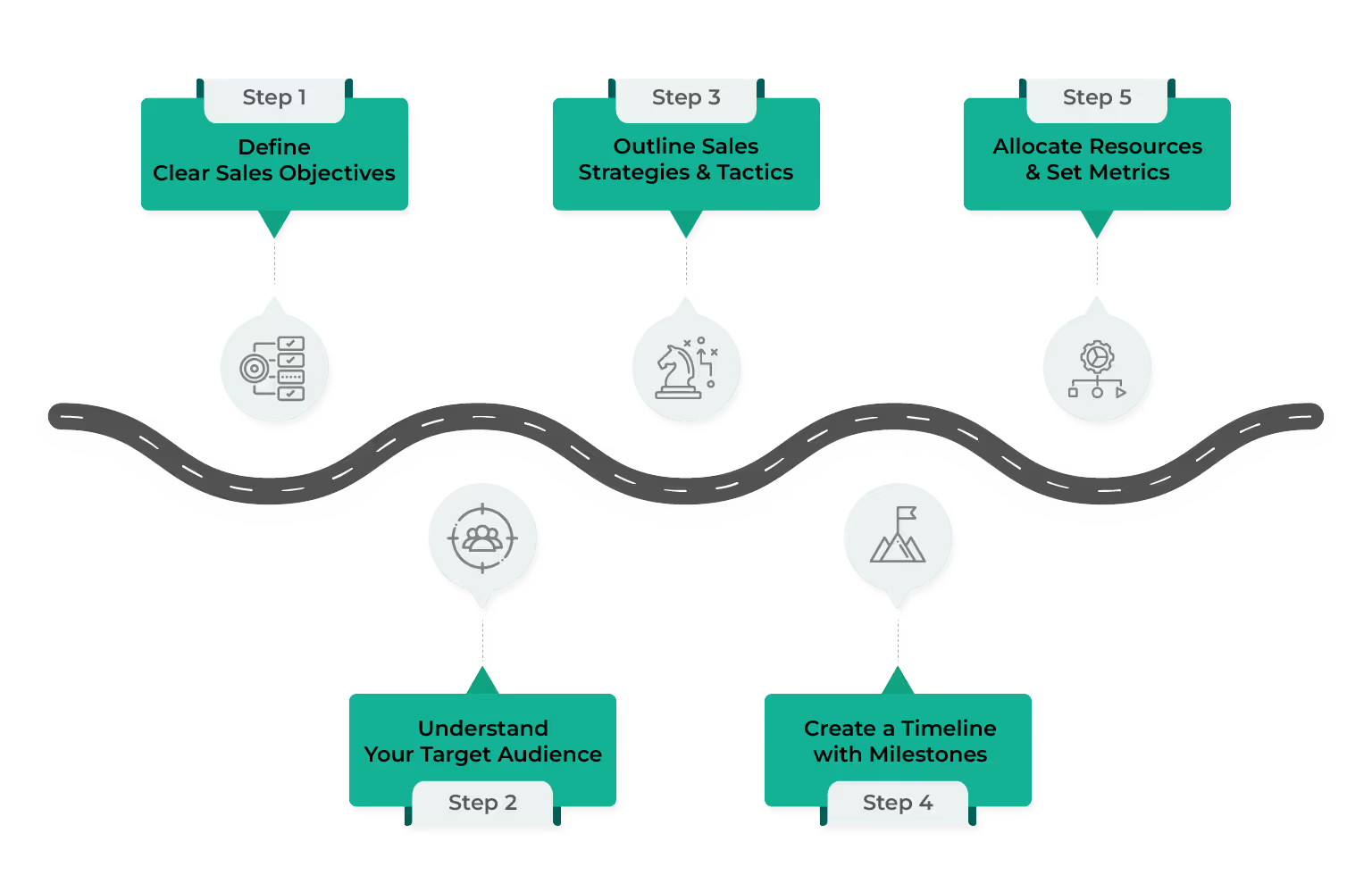
Blog
How to Develop a Strategic Sales Roadmap for Your Business?
December 28, 2023


Key Insights
The most important role of a leader is to set a clear direction, be transparent about how to get there and to stay the course. - Irene Rosenfeld
Sales managers should make an effort to inform their team about both long and short-term objectives, the strategies the intend to implement, and the milestones that serve as indicators of progress in the desired direction.
These efforts, discussions, and collaboration update the entire team about the things that they have achieved and what the need to achieve in the future. This clarity and sense of direction have a huge impact on their overall performance.
In this article we will delve into sales roadmaps, how roadmaps win over their customers, the key elements of a sales roadmap, and the five steps to creating an effective sales roadmap for your sales team.
So scroll down for more.
What is a sales roadmap?
A sales roadmap is a strategic plan that outlines the steps involved in achieving sales objectives and goals. It serves as a visual representation of the sales strategy, providing a timeline and clear direction for the sales team.
The roadmap typically includes key activities, tasks, and initiatives that need to be executed to drive sales growth and meet targets. It can be a valuable tool for communication and collaboration within the sales team and other departments in the organization.
What are the key elements of a sales roadmap?
A sales roadmap typically includes several key elements to provide a comprehensive plan for achieving sales objectives. Here are a few key elements of a sales roadmap.

Sales Goals and Objectives
Clearly defined and measurable sales goals are fundamental to any roadmap for sales targets. Setting these goals helps align the sales objectives with the overall business targets such as revenue figures, market share, customer acquisition, or sales growth percentages.
Additionally, integrating a robust sales transformation strategy can further enhance the effectiveness of these goals by leveraging innovative technologies, streamlined processes, and skill development to drive sustainable and transformative changes in the sales approach.
Timeline and Milestones
Sales roadmap must also include a well-structured timeline to provide a sense of direction and urgency. It must also outline key milestones and deadlines for achieving specific objectives. This helps in organizing tasks and activities over a specified period and provides a clear path to success.
Sales Strategies and Tactics
Building a sales roadmap will help outline the strategies and tactics that the sales team must employ to achieve their defined goals. This includes details about lead generation, prospecting, customer outreach, sales presentations, negotiation strategies, and closing techniques.
Customer Segmentation and Targeting
Sales roadmap helps identify the target customers and provide details on how the sales team will approach each segment. This involves defining buyer personas, understanding customer needs, and tailoring sales strategies to address the unique requirements of different customer groups.
Sales Channels and Distribution
Sales roadmap specifies the various sales and distribution channels that will be utilized. This could include direct sales, online sales, partnerships, resellers, or other distribution methods. Clearly outline how each channel contributes to the overall sales strategy. Additionally, aligning each channel with specific Sales OKRs (Objectives and Key Results) ensures a focused and measurable approach, fostering accountability and driving the team towards achieving targeted sales outcomes.
Resource Allocation
Sales roadmap details the resource allocation necessary for successful execution. Assigning budget considerations, personnel requirements, technology tools, and any other resources critical to implementing the sales plan ensures that resources a realigned with the priorities outlined in the roadmap.

Key Performance Indicators
Sales roadmap defines the metrics and KPIs that will be used to measure the success of the sales efforts, often incorporating a robust sales growth calculator. Common metrics include conversion rates, sales velocity, customer acquisition costs, customer lifetime value, and other relevant performance indicators. Regularly tracking and analyzing these metrics helps monitor the progress and make data-driven decisions.
Sales roadmaps must be regularly reviewed and adapted to ensure that they remain relevant and effective in guiding the sales team toward success.
For further reading, check Inspiring Your Team: Clear Sales Objectives Examples.
How does a sales roadmap win over customers?
A well-developed sales roadmap template provides a structured approach to your sales process. So let's look at some ways that sales roadmap helps wingover customers:
● A sales roadmap provides a clear understanding of customer needs and pain points. This helpssales reps to take the required steps to tailor their customer approach andaddress their specific requirements.
● Knowing who your customers are and what their needs are helps in crafting targeted and relevant communication strategies. This helps the sales team communicate their value propositions effectively and demonstrate how the product resolves their challenges.
● A sales roadmap anticipates potential objections or concerns customers may have and includes strategies to address them. This proactive approach helps sales representatives respond effectively and thereby overcome the barriers to the sale.
● Sales roadmap ensures consistency in the customer experience. From the initial contact to post-sale support, a well-defined roadmap guides the sales team in maintaining a consistent and positive experience for the customer.
● Sales roadmaps include information about resource allocation, such as budget, personnel, and technology. This enables sales teams to ensure Hey have the necessary resources to execute their sales plans effectively.
● Sales roadmaps are dynamic and responsive to customer feedback. Regular reviews and adaptations based on customer interaction sallow the sales team to refine their approach, ensuring it aligns with evolving customer needs and preferences.
Sales roadmaps that are customer-centric, transparent, and adaptable can significantly contribute to winning over customers by aligning sales activities with effective strategic planning and customer needs and expectations throughout the entire buying journey.
Incorporating diverse and customer-focused sales approaches, such as consultative selling, relationship building, and value-driven solutions, enhances the roadmap's effectiveness in addressing the evolving dynamics of the market and ensuring sustained customer satisfaction.
Looking to enhance your sales roadmap through sales performance, check What Is Sales Performance Evaluation and Why It Matters?
5 steps to creating a sales roadmap
Creating a sales roadmap involves strategic planning and organization. Here are five steps to guide you through the process:

Define Clear Sales Objectives
Crafting your own sales roadmap starts by clearly defining your sales objectives. These include revenue targets, MarketShare growth, customer acquisition numbers, or other key performance indicators. Your sales roadmap must ensure that your objectives align with the overall business strategy.
Understand Your Target Audience
Sales roadmap must identify and understand your target audience. Create buyer personas that represent your ideal customers by considering factors such as demographics, behavior, pain points, and preferences. This understanding will inform your sales strategies and help you tailor your approach to meet the needs of your customers.
Outline Sales Strategies and Tactics
Sales roadmaps must develop detailed strategies and tactics to achieve your sales objectives. This encompasses the entire sales process, from lead generation to post-sale engagement. Consider the specific actions and activities to move leads through the sales funnel and outline your approach to prospecting, nurturing, closing deals, and providing ongoing support.
Additionally, distinguishing between the sales funnel and sales pipeline, and giving an example of the selling concept in marketing in your roadmap ensures a clear understanding of customer progression and sales stages. This aids in precise tracking, analysis, and optimization of the overall sales strategy.
Create a Timeline with Milestones
Sales roadmaps must establish a realistic timeline. Breaking down your sales strategies into actionable steps and setting milestones for each stage helps create a sense of urgency and provides a structured implementation plan.
Allocate Resources and Set Metrics
Sales roadmaps must determine the resources needed for successful execution. This includes budget allocation, personnel requirements, and any technology or tools required to support the sales process. Define key performance indicators (KPIs) and metrics that will be used to measure success, such as the sales velocity calculator. Common metrics include conversion rates, customer acquisition costs, and revenue growth.
The effectiveness of a successful sales roadmaps in being dynamic to the changes and feedback and evolving to adapt to these changes to enhance sales growth.
For further reading, check How to Implement Sales OKRs for Maximum Sales Growth?
Final thought
Having a clear sense of direction and guidance is beneficial in any work setting.
Organizations must invest time and effort in building a roadmap that clarifies their teams. For example, the requirements and expectations between sales associates vs sales executives are distinct.
Providing a route map helps them understand what is expected of them, where to direct their focus, and how to achieve their objectives.
However, a sales roadmap is not a static document. it must be flexible enough to adapt to changes in the market, customer feedback, and other external factors. Regular review and update of the sales roadmap ensures its relevance and effectiveness in guiding your sales team toward achieving its goals.
In addition, organizations and managers must encourage transparent communication and seamless collaboration among team members to ensure everyone is aligned with the roadmap and working towards common objectives.
Knowing the destination and the path to take makes the task half accomplished.
To read more about sales-related topics, connect with Kennet. For more information, Book A Demo Today.
ReKennect : Stay ahead of the curve!
Subscribe to our bi-weekly newsletter packed with latest trends and insights on incentives.
Thank you! Your submission has been received!
Oops! Something went wrong while submitting the form.
Your data is in safe hands. Check out our Privacy policy for more info











